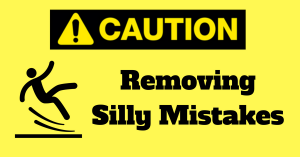
One of the biggest questions I regularly get asked is around how to remove silly mistakes. Of course it is a great question and it is very important because, as you may have seen, silly mistakes can affect the overall test score considerably.
Whilst it is often hoped that the child will grow out of this and on the big day they will magically disappear, I’d prefer to have a little more control and structure to increase the chances of that being the case.
So, I hope this process finds you well and helps you in your plight to remove those pesky, silly mistakes.
But I didn’t dream this up overnight and I want to give credit to this learning which has been taken from Anish Passi who has shared his conceptual and test-taking expertise with students over the last decade. I have simply tweaked the main concepts and made it applicable to AQE / GL students. Before launching into the process, Anish recommends that everyone realises two small points:
1. We all make silly mistakes. He goes further to suggest that if you feel you do not make silly mistakes while practicing, you’re either not practicing or not looking hard enough.
2. Making silly mistakes is a systemic problem. What he means by this is that many a times we brush off silly mistakes as one-off cases. (“Surely I’ll not repeat such a mistake again.”). If silly mistakes were “one-off”, wouldn’t you be done with them by now?
The 5-Stage Process To Removing Silly Mistakes
- Identify The Silly Mistake
- Classify Into Categories
- Figure Out Root Cause
- Eliminate Silly Mistakes
- Taking Countermeasures
Step 1: Identify The Silly Mistake

This first stage requires that a log is maintained detailing all the silly mistakes when they occur. It is important that this activity takes place over a good period of time before the date of the test, so that trends can be identified and remedial action put in place.
This log can be on a piece of paper or a computerised log, but it is important that it exists and is used regularly over the prep time.
Step 2: Classify Into Specific Categories

All silly mistakes can primarily be classified into two broad types:
- Reading / Misunderstanding The Question
- Solving / Calculating The Answer
N.B. If you find that the child did not know how to approach the question, this is not a silly mistake, this is a knowledge gap which can be plugged with further revision and focus on that topic.
Then do a further deep-dive and explain further. For example, your log may now say:
Silly Mistake 1:
- Calculating
- Mistake – 2 x 3 = 5
Silly Mistake 2:
- Reading
- Mistake – Read 7 as a 1 in working out.
Step 3: Figure Out Root Cause

This step is very important and will help you understand what you really need to eliminate and step 4 becomes very easy, so take time to carefully consider why this silly mistake occurred. This should also be noted on your log and below is our continued example:
Silly Mistake 1:
- Calculating
- Mistake – 2 x 3 = 5
- No evidence of rough work and done in head
Silly Mistake 2:
- Reading
- Mistake – Read 7 as a 1 in working out
- Working out was small and messy and squeezed into a tiny gap
Step 4: Eliminate Silly Mistakes

Once you have identified the root cause behind the silly mistake, figuring out ways to eliminate the root cause is comparatively easy.
Some examples are expanded below to give you a flavour of this process:
- Root Cause 1: Six silly mistakes in the log show that this is because there is no evidence of rough work and calculations are being done in the head.
- Solution 1: make sure that all calculations are done on paper as this will also support the ability to be able to quickly check for silly mistakes at the end (there is no time to re-read the whole question but you can check calculations).
- Root Cause 2: Ten silly mistakes were due to messy rough work and not being able to read the numbers properly, regularly mixing up the 7 and 1, and the 6 and 0.
- Solution 2: Stop being messy. Ok, you are not likely to change your handwriting overnight, but make a conscious effort to be neater as it is clearly costing you important marks. Don’t try to squeeze everything into one rough work sheet, ask for more paper. Space out your calculations and write in a logical fashion down the page, not sporadic and randomly all over the place.
Step 5: Taking Countermeasures

Countermeasures are ways in which you can ensure that you don’t make the silly mistake in the first place or they can be a sanity check at the end. With the root causes identified for your child, you will want to design a number of countermeasures that can be the final step in making sure these mistakes are eliminated.
So, some examples:
- If your child made the mistake of 7 x 9 = 56, a sanity check could be ‘two odd numbers multiplied will produce an odd number answer‘, so this mistake would have been caught.
- If you child was working out the average of 5 numbers which were 6.3, 7.4, 8.3, 7.8 and 5.3 and they worked out the answer to be 4.5, a sanity check could simply be ‘does that make sense‘, ‘is that likely to be right’.
- If you child always got lost in the calculations and answered the question he thought he should be asked, rather than what he was being asked, then a countermeasure could be ‘underline the actual question‘ or ‘quickly write the actual question on the rough work paper‘. This could also be a root cause solution.
Each child is unique and so this analysis needs to happen for each individual child and one size will not fit all, but I hope that I have armed you with a tool that you can take to move forward with the objective of removing silly mistakes, rather than simply hoping the big day will be any different than any other time.